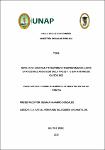Niveles de ansiedad y trastornos temporomandibulares en pacientes atendidos en la IPRESS 1 - 3 San Antonio de Iquitos 2022
Abstract
The object of study was to indicate the relationship between Anxiety Levels and Temporomandibular Disorders (TMD) in patients treated at the IPRESS I-3 San Antonio, 2022. The research was quantitative, the design was non-experimental, correlational, cross-sectional. The proportion of the population group was 366 individuals treated in the dental area of the establishment. Anxiety Inventory, Trait-State (IDARE) and the Research Diagnostic Criteria (CDI) instrument for TTM were used. The most notable results were: there was a statistically significant association between age and Temporomandibular Disorders (p=0.003). In marital status, married people exhibited a statistically significant association with Temporomandibular Disorders (p=0.009), highlighting myalgia. The prevalence of TMD at the San Antonio Health Center was high (68.2%). The average level prevailed in both Anxiety-Trait and Anxiety-State. Myalgias predominated in the diagnoses of Temporomandibular Disorders. Finally, it was inferred that there is a relationship between Temporomandibular Disorders, Anxiety-State and Anxiety-Trait (p=0.000). El objeto de estudio fue señalar la relación entre Niveles de Ansiedad y Trastornos Temporomandibulares (TTM) en pacientes atendidos en la IPRESS I-3 San Antonio, 2022. La investigación fue cuantitativa, el diseño fue no experimental, correlacional, transversal. La proporción del grupo poblacional fue de 366 individuos tratados en el área dental del establecimiento. Se empleó Inventario de Ansiedad, Rasgo-Estado (IDARE) y el instrumento de Criterios de Diagnóstico de Investigación (CDI) para TTM. Los resultados más notables fueron: entre edad y Trastornos Temporomandibulares hubo asociación estadísticamente significativa (p=0,003). En estado civil, los casados exhibieron asociación estadísticamente significativa con los Trastornos Temporomandibulares(p=0,009), resaltando las mialgias. La prevalencia de TTM del Centro de Salud de San Antonio fue elevada (68,2%). El nivel medio prevaleció tanto en Ansiedad-Rasgo como Ansiedad-Estado. En los diagnósticos de Trastornos Temporomandibulares predominaron las mialgias. Finalmente, se infirió que existe relación entre los Trastornos Temporomandibulares, Ansiedad-Estado y Ansiedad-Rasgo (p=0,000).


